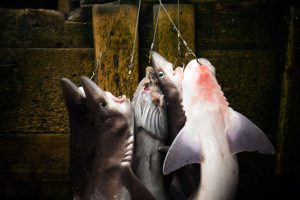
Wildlife
The great green shark hunt
Can British Columbia’s spiny dogfish make the grade as the world’s first “sustainable” shark fishery?
- 3319 words
- 14 minutes
This article is over 5 years old and may contain outdated information.
Wildlife

There’s spending time in a school, and then there’s spending time at a school. The former is normal for fish, but the latter isn’t — unless they happen to be one of the cod fitted with a dime-sized device that looks like a backpack, swimming around under the watchful eye of Franziska Broell at the marine and freshwater Aquatron Laboratory at Dalhousie University, in Halifax.
The “backpack” is an accelerometer — a device that measures changes in gravitational pull or movement — that Broell and fellow graduate student Andre Bezanson built to record the movement of a fish as part of Broell’s Ph.D. research in biological oceanography. Attached just below the dorsal fin, the battery-operated accelerometer continuously samples and records data to a microSD card at a rate of 500 hertz, or 500 movements per second. Although the device records the movement of the whole fish, the prominent data relates to the tail.
Recording how frequently a fish moves its tail can indicate the fish’s size, since a small fish needs to move its tail more often than a large fish to swim at the same pace. “The easiest way to explain it is to imagine a kid and a dad,” says Broell. “The kid has to take more steps to keep up with the dad. The same concept applies to fish.”
Broell hopes to translate the data she’s collected in the lab into a species- specific model that can be used to measure growth. In the field, for instance, such a model could help assess how variations in water temperature caused by climate change affect fish growth. It could also help determine the health of a fishery and thus assist in establishing guidelines for sustainable fishing.
Combining Broell’s device with a pop-up satellite archival tag, which tracks and transmits the fish’s location, would also enable researchers to record and trace movement-specific behaviour such as feeding and spawning — something that could come in handy for conservation purposes. “It’s good to know where certain animals are feeding,” says Broell. “If you can find out where the fish are, you can try to protect the habitat.”
Are you passionate about Canadian geography?
You can support Canadian Geographic in 3 ways:

Wildlife
Can British Columbia’s spiny dogfish make the grade as the world’s first “sustainable” shark fishery?

History
From their beginnings in the late 19th century, salmon hatcheries have gone from cure to band-aid to crutch. Now, we can’t live without manufactured fish.

People & Culture
A moratorium on cod fishing that was supposed to last two years has now lasted 30. What will it take to rebuild cod stocks — and a way of life?

Wildlife
An estimated annual $175-billion business, the illegal trade in wildlife is the world’s fourth-largest criminal enterprise. It stands to radically alter the animal kingdom.